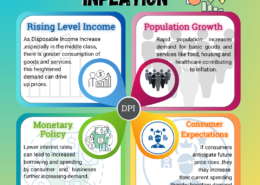Examine the long-term structural causes of India’s ongoing inflationary pressures, including the labor market’s rigidities, some industries’ lack of competition, and supply chain’s overall inefficiencies. Then, evaluate the government’s initiatives to address these root causes.
Effectiveness of RBI's Forward Guidance and Communication Strategies The Reserve Bank of India (RBI) employs forward guidance and communication strategies as essential tools for anchoring inflation expectations and maintaining the credibility of its monetary policy framework. Evaluating the effectivRead more
Effectiveness of RBI’s Forward Guidance and Communication Strategies
The Reserve Bank of India (RBI) employs forward guidance and communication strategies as essential tools for anchoring inflation expectations and maintaining the credibility of its monetary policy framework. Evaluating the effectiveness of these strategies involves examining recent actions, communication techniques, and their impact on inflation expectations and policy credibility.
1. Forward Guidance Mechanism
- Definition and Purpose: Forward guidance refers to the RBI’s use of communication to provide insights into the future path of monetary policy. Its primary purpose is to shape market expectations and influence economic decisions by providing clarity on the likely trajectory of interest rates and policy actions.
- Recent Examples: In response to rising inflation and economic uncertainties, the RBI has used forward guidance to signal its policy stance. For instance, in August 2023, the RBI’s communication emphasized a cautious approach towards inflation, indicating that monetary policy would remain data-driven. This was aimed at managing market expectations and providing clarity on the likely direction of policy adjustments.
2. Communication Strategies
- Transparency and Clarity: The RBI’s communication strategies focus on transparency and clarity to effectively manage market expectations. Regular Monetary Policy Committee (MPC) meetings and the publication of the RBI’s Monetary Policy Reports offer insights into the economic outlook and policy decisions. For example, the August 2024 Monetary Policy Statement provided detailed assessments of inflation trends and economic conditions, helping to clarify the RBI’s stance.
- Use of Press Conferences and Speeches: The RBI Governor’s press conferences and speeches are crucial in conveying the central bank’s policy intentions and economic outlook. In recent months, speeches by Governor Shaktikanta Das have addressed concerns about inflation and the need for balanced monetary policy, which have been instrumental in shaping market perceptions and expectations.
3. Anchoring Inflation Expectations
- Effectiveness in Controlling Inflation: Effective forward guidance and communication help in anchoring inflation expectations, thereby influencing actual inflation outcomes. The RBI’s consistent messaging regarding its commitment to controlling inflation has played a role in moderating expectations. For instance, despite a spike in inflation in early 2023, the RBI’s clear communication about its inflation targets and policy response helped in stabilizing market expectations.
- Recent Trends: In 2024, inflationary pressures persisted due to global commodity price fluctuations and domestic supply chain disruptions. The RBI’s guidance, focusing on its inflation targeting framework and willingness to adjust rates as needed, has helped maintain a degree of confidence among investors and market participants.
4. Credibility of Monetary Policy Framework
- Consistency and Policy Actions: The credibility of the RBI’s monetary policy framework is largely built on the consistency of its forward guidance and policy actions. The RBI’s adherence to its inflation targeting framework, along with timely policy interventions, reinforces its commitment to price stability. For example, the RBI’s decision to increase the repo rate in February 2024, following a period of high inflation, demonstrated its commitment to managing inflation, thereby supporting its credibility.
- Challenges and Criticisms: Despite its efforts, the RBI faces challenges in maintaining credibility, particularly when there are deviations from expected policy paths or delays in policy responses. Criticisms have arisen when inflation exceeded targets or when policy actions were perceived as insufficient. Addressing these challenges involves improving the effectiveness of communication and ensuring timely and appropriate policy measures.
5. Impact on Financial Markets and Economic Behavior
- Market Reactions: Effective forward guidance helps stabilize financial markets by reducing uncertainty about future monetary policy. For example, the RBI’s clear guidance on interest rate trajectories has influenced bond market yields and currency exchange rates, contributing to financial market stability.
- Economic Decision-Making: Clear communication from the RBI influences consumer and business expectations, impacting their spending and investment decisions. By managing expectations through forward guidance, the RBI helps in aligning economic behavior with its policy objectives, thereby supporting overall economic stability.
Conclusion
The RBI’s forward guidance and communication strategies have been effective in anchoring inflation expectations and maintaining the credibility of its monetary policy framework. Recent examples illustrate the RBI’s efforts to manage market expectations and provide clarity on its policy stance. However, maintaining this effectiveness requires ongoing consistency in communication, timely policy responses, and addressing any emerging challenges to uphold the central bank’s credibility and achieve its inflation and economic stability objectives.
See less

India has faced persistent inflationary pressures over the years, which can be attributed to several long-term structural factors: 1. Labor Market Rigidities: The Indian labor market is characterized by rigidities, such as complex labor regulations, limited mobility of workers, and a large informalRead more
India has faced persistent inflationary pressures over the years, which can be attributed to several long-term structural factors:
1. Labor Market Rigidities:
2. Lack of Competition in Certain Sectors:
3. Inefficiencies in the Supply Chain:
4. Dependence on Imports:
5. Structural Bottlenecks in the Agricultural Sector:
Government Efforts to Address Underlying Issues:
The Indian government has undertaken various measures to address the structural factors underlying the country’s persistent inflationary pressures:
1.Labor Market Reforms:
2. Promoting Competition:
3. Supply Chain Modernization:
4. Agricultural Reforms:
5. Monetary Policy and Fiscal Measures:
While these efforts have had some impact, the persistence of inflationary pressures in India suggests that more comprehensive and sustained actions are needed to address the deep-rooted structural issues. Continued focus on labor market reforms, promoting competition, supply chain modernization, and agricultural productivity improvements will be crucial in the long run to enhance the resilience of the Indian economy and mitigate inflationary risks.
See less